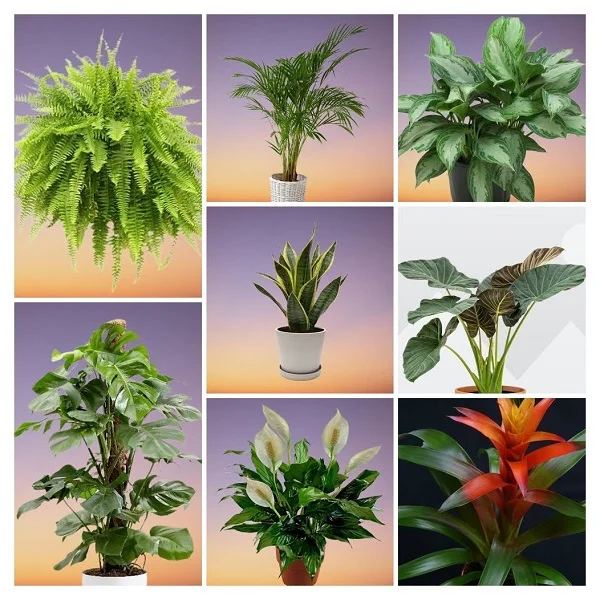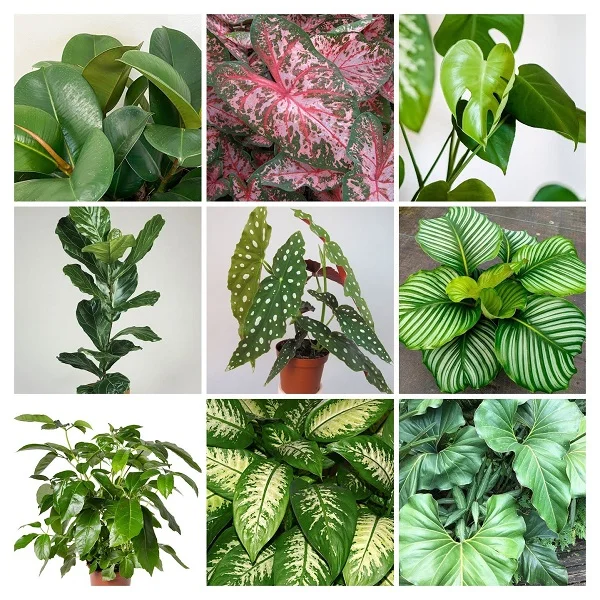24 Best Indoor Trees to Spruce Up Your Home (Best Trees for Growing Indoors)
Some links in this post may be affiliate links
Indoor Trees are plants that make a bold statement in any space and are ideal for filling up the large spaces. They are also good in cleaning indoor air.
Some of these trees are easy to grow under room conditions and generally require little attention. While selecting a tree for your space, consider the level of maintenance required as well as the available space.
A few of the trees can grow quite large, however, the size can be controlled by pruning. We have below outlined for you 24 best indoor trees that you may grow to spruce up your home (with care guides)
24 Best Trees for Indoors with Care Guides
The best trees for indoors include Madagascar Dragon Tree, Rubber Plants, Palms, Umbrella Tree, Lace Tree Philodendron, Fiddle Leaf Fig, Aralia balfouriana, Spineless Yucca among others. Keep reading for the complete list.
1. Madagascar Dragon Tree
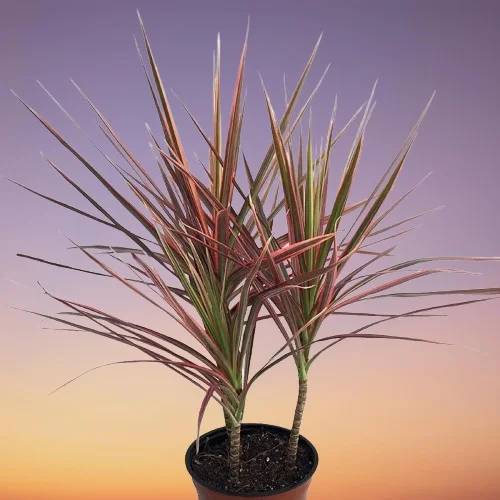
Botanical name: Dracaena marginiata
Common name: Madagascar Dragon Tree
Origin: Madagascar and other Indian Ocean Islands
Height: 8-10 ft
Madagascar Dragon Tree thrives in bright, indirect light away from direct sunlight, average warmth and moderately moist, rich, well-drained soil coupled with monthly feeding during the growing season.
Read more on how to grow and care for Madagascar Dragon Tree (Dracaena marginata)
2. Rubber Plants

Botanical name: Ficus elastica
Common names: Rubber Plant, Rubber Fig, Rubber Tree, Rubber Bush, Indian Rubber Tree, Indian Rubber Bush
Origin: Eastern parts of South Asia and Southeast Asia
Height: 6-10 ft
Rubber Plants are popular, large plant and a great popular large-leafed plants that make a bold statement in any space and easily adapt to a wide range of growing conditions.
There are many varieties of Rubber Tree like Ficus elastica 'Decora', Ficus elastica 'robusta' (Bronze Rubber Plant), Ficus elastica 'Black Prince', Ficus elastica 'Tineke', Ficus elastica 'Shivereana' among others.
Ficus elastica blossom in bright light with 4-6 hours of direct sunlight, average warmth of 15-280C, moderate humidity of 50-55% and moderately moist, fertile, well-drained, all purpose potting soil coupled with monthly feeding during the growing season.
Learn more on how to grow and care for Rubber Plants (Ficus elastica)
3. Areca Palm
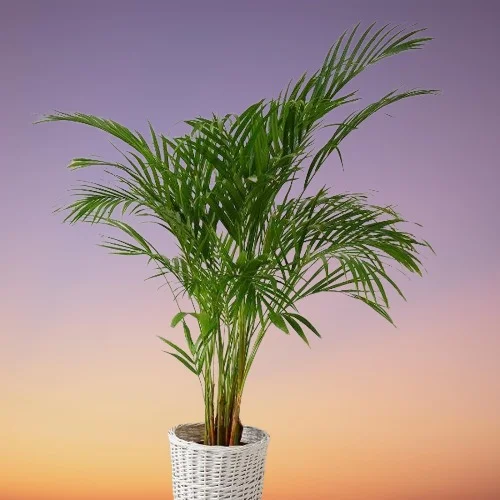
Botanical name: Dypsis lutescens
Common names: Areca Palm, Butterfly Palm, Golden Cane Palm, Yellow palm
Origin: Madagascar
Height: 6-10 ft
Areca Palm prefers bright, indirect light away from hot direct sunlight, average warmth and humidity and moderately moist, fertile, well-drained soil accompanied by monthly feeding during the growing season.
Read more on how to grow and care for Areca Palm (Dypsis lutescens)
4. Dwarf Umbrella Tree
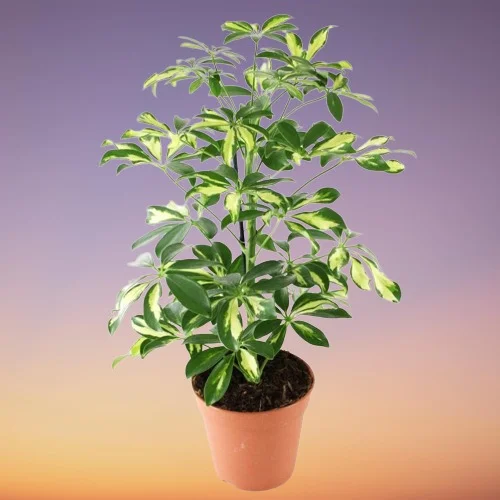
Botanical name: Schefflera arboricola
Common names: Dwarf Umbrella Tree, Hawaiian Schefflera, Dwarf Schefflera
Origin: Taiwan and Hainan
Height: 4-6 ft
Dwarf Umbrella Tree is a delightful plant with about ten leaflets radiating from each leaf-stalk on account of its ability to easily adapt to various growing conditions.
Hawaiian Schefflera is much easier to grow than its relative Schefflera actinophylla (Umbrella Tree). Dwarf Umbrella Tree will happily grow as a bush if the growing tip is removed.
Schefflera arboricola thrives in medium to bright light (dappled light), moderate warmth of 16-280C, average humidity of 50-55% and moderately moist, fertile, well-drained, all purpose soil coupled with monthly feeding during the growing season.
Learn more on how to grow and care for Dwarf Umbrella Tree (Schefflera arboricola)
5. Fiddle Leaf Fig
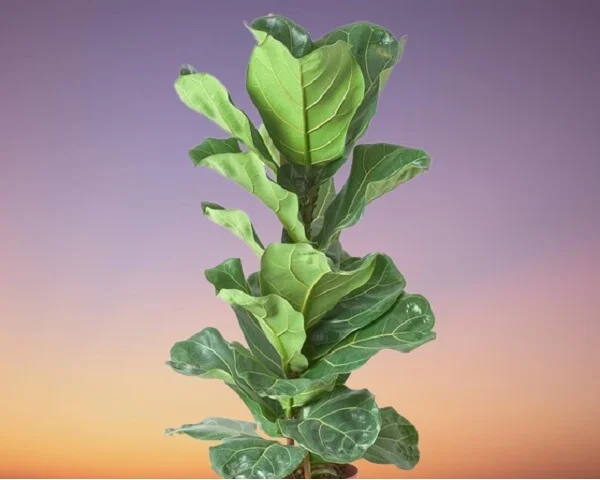
Botanical name: Ficus lyrata
Common name: Fiddle Leaf Fig
Origin: western Africa; Cameroon West to Sierra Leone
Height: 6-10 ft
Fiddle Leaf Fig prefers bright light with some direct sunlight, warm and humid conditions and moderately moist, fertile, well-drained soil coupled with monthly feeding during the growing season.
Read more on how to grow and care for Fiddle Leaf Fig (Ficus lyrata)
6. Fishtail Palm
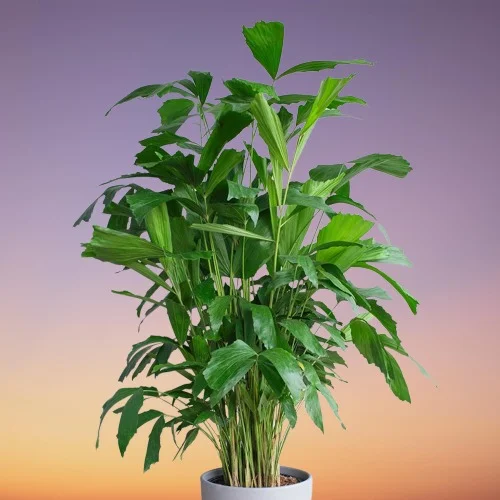
Botanical name: Caryota mitis
Common names: Fishtail Palm, Clustering Fishtail Palm
Origin: Tropical Asia; India to Java to Southern China
Height: 6-8 ft
Fishtail Palm requires bright, indirect light away from direct sunlight and moderately moist, rich, well-drained soil coupled with regular feeding during the growing season.
Learn more on how to grow and care for Fishtail Palm (Caryota mitis)
7. Aralia balfouriana
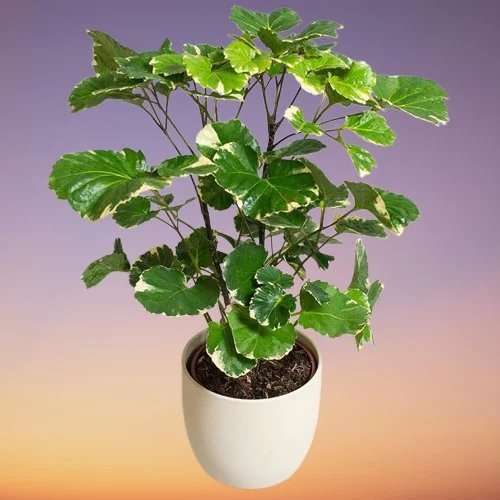
Botanical name: Polyscias balfouriana
Common names: Aralia balfouriana, Dinnerplate Aralia, Balfour Aralia
Origin: New Guinea to Queensland, Australia
Height: 8 ft
Aralia balfouriana like Ming Aralia (Polyscias fruticosa) thrives in bright light away from direct sunlight, warm and humid conditions and moderately moist, fertile, well-drained, all purpose soils coupled with monthly feeding during the growing season.
Read more on how to grow and care for Aralia balfouriana (Polyscias balfouriana)
8. Spineless Yucca

Botanical name: Yucca gigantea
Common names: Spineless Yucca, Soft-tip Yucca, Blue-stem Yucca, Giant Yucca, Yucca Cane, Itabo
Origin: Mexico and Central America
Height: 8-10 ft
Yucca gigantea is an ideal False Palm for a hallway or large space in which a woody trunk bears a crown of long, leathery, strap-like, spineless leaves and white bell-shaped flowers may appear on mature plants.
Blue-stem Yucca requires a deep, well-drained container and a well-lit spot with some sunshine inorder to thrive. It is among the popular sun-loving plants for the home.
Yucca gigantea requires very bright light with 6-8 hours of direct sunshine, average warmth of 16-280C, moderate humidity of 50-55% and moderately moist, well-drained, fertile, succulents mix coupled with monthly feeding during the growing season.
Learn more on how to grow and care for Spineless Yucca (Yucca gigantea)
9. Copperleaf Plant
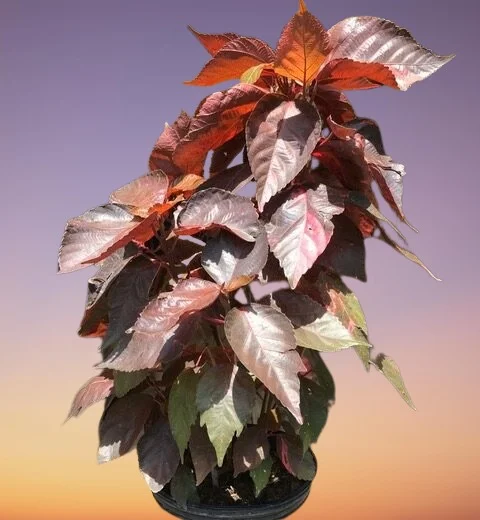
Botanical name: Acalypha wilkesiana
Common name: Copperleaf Plant, Jacob's Coat, Fire Dragon Plant
Origin: Fiji islands, New Caledonia
Height: 9-10 ft
Acalypha wilkesiana also called Jacob's Coat or Fire Dragon is a popular, vibrant tree-like plant which exhibits attractive leaf colors making it a great accent plant in any space.
Its broad, ovate to heart-shaped, serrated leaves can range from red, copper, bronze to pink, green and white, giving them a beautiful vibrant appearance. It is among the best plants for the living room where it will create a delightful first impression.
Acalypha wilkesiana prospers in bright, indirect light away from direct sunlight (filtered light), moderate warmth of 18-270C, humidity of 55-70% and evenly moist, rich, well drained, all purpose soil coupled with fortnightly feeding in the growing season.
Learn more on how to grow and care for Copperleaf Plant (Acalypha wilkesiana)
10. Ficus Audrey
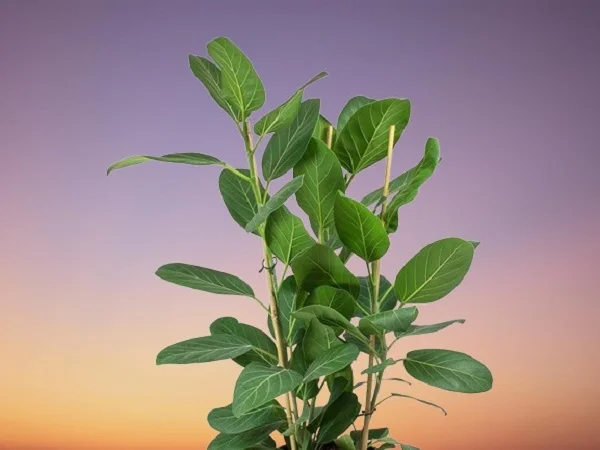
Botanical name: Ficus benghalensis 'Audrey'
Common names: Ficus Audrey, Bengal Fig, Banyan Fig, Banyan Tree, Indian Banyan, Strangler Fig
Origin: India, Sri Lanka, Pakistan
Height: 5-10 ft
Ficus benghalensis 'Audrey' thrives in bright light with some morning or late afternoon sunlight, warm and humid conditions and moderately moist, rich, well-drained soil coupled with monthly feeding during the growing season.
Learn more on how to grow and care for Ficus Audrey (Ficus Audrey)
11. Lacy Tree Philodendron
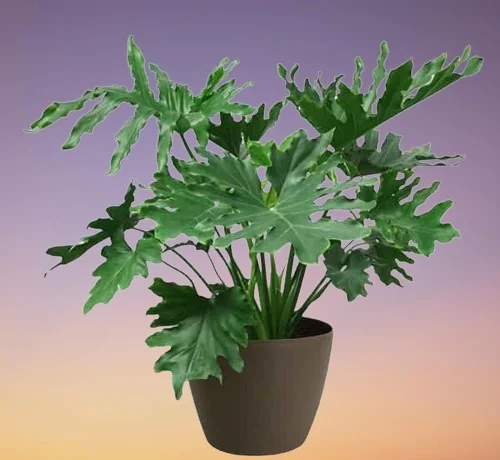
Botanical name: Philodendron selloum, Thaumatophyllum bipinnatifidum, Philodendron bipinnatifidum
Common names: Lacy Tree Philodendron, Horsehead Philodendron
Origin: Brazil, Bolivia, Argentina, Paraguay
Height: 5-6 ft
Lacy Tree Philodendron is among the non-climbing Philodendron varieties with simple, large, deeply-lobed, ruffle-edged, drooping, dark-green leaves and is most impressive in a large space for a bold statment.
Thaumatophyllum bipinnatifidum like Philodendron 'Summer Glory' and Philodendron selloum 'Sun Red' is a non-climbing, upright bush which looks magnificent in a pot. Use a moss pole to give it support and for it to grow the large magnificent leaves.
Philodendron selloum prospers in medium to bright indirect light (filtered light), average warmth of 18-260C, humidity of 55-65% and moderately moist, rich, well-drained, aroids potting mix coupled with monthly feeding during the growing season.
Read more on how to grow and care for Lacy Tree Philodendron (Philodendron selloum)
12. Barberton Groundsel
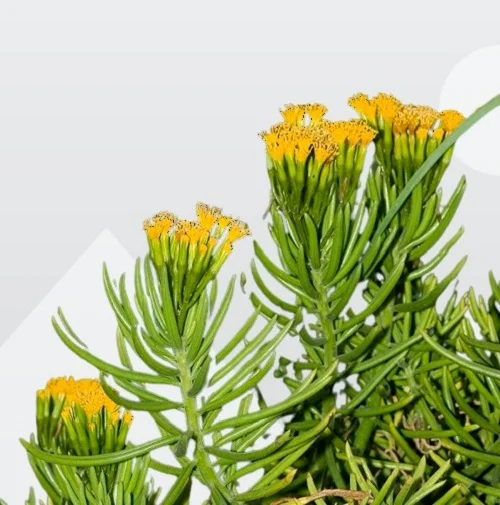
Botanical name: Senecio barbertonicus
Common names: Barberton Groundsel, Succulent Bush Senecio, Barberton Senecio
Origin: Mozambique, Swaziland, Zimbabwe, eastern South Africa
Height: 6 ft
Barberton Groundsel also called Succulent Bush Senecio or Barberton Senecio is among the perennial Senecio plants varieties which is densely packed with lime-green, finger-like, fleshy leaves on fleshy stems.
Senecio barbertonicus flourishes in bright light with 4-6 hours of direct sunshine, average warmth of 20-260C, moderate humidity of 50-55% and moderately moist, rich, well-drained, succulents soils coupled with regular feeding during the growing season.
Learn more on how to grow and care for Barberton Groundsel (Senecio barbertonicus)
13. Triangle Leaf Fig
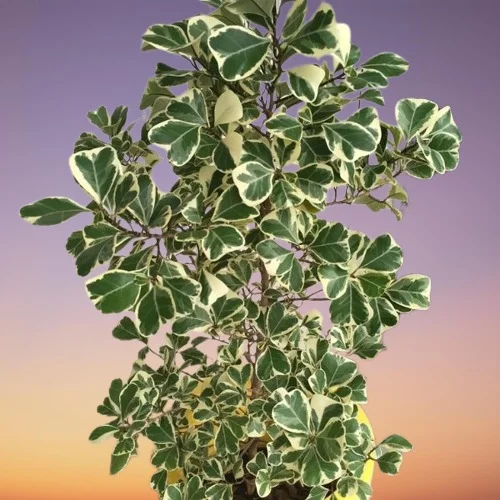
Botanical name: Ficus triangularis
Common name: Triangle Leaf Fig
Origin: South and West Africa
Height: 4-6 ft
Triangle Leaf Fig grows best in bright light with some direct sunlight, warm and humid conditions and moderately moist, well-drained soil which is rich in organic matter coupled with monthly feeding during the growing season.
Read more on how to grow and care for Triangle Leaf Fig (Ficus triangularis)
14. Angel Wing Begonia
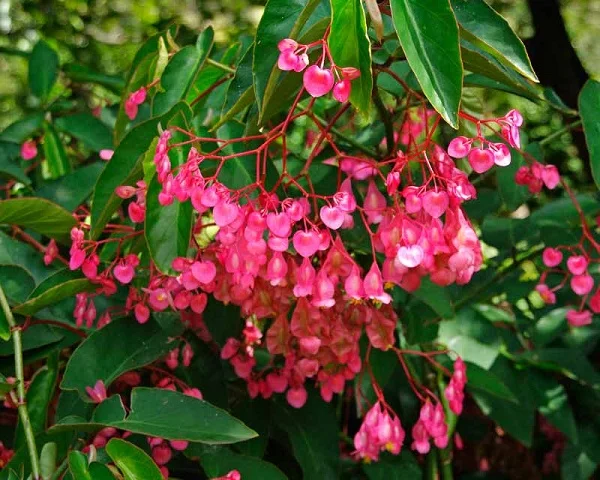
Botanical name: Begonia coccinea
Common name: Angel Wing Begonia, Scarlet Begonia
Origin: Atlantic Forest of Brazil, distributed in Rio de Janeiro and Espírito Santo
Height: 6-8 feet
Angel Wing Begonia also called Scarlet Begonia is one of the popular Begonia plants varieties and comes with large, glossy, red-margined leaves. The leaves are 'angel wing' shaped and hence the common name.
Scarlet Begonia is an evergreen, shrubby, flowering plant which bears large clusters of waxy flowers which hang from the stems and come in red, white, orange and pink. Like Polka Dot Begonia (Begonia maculata) and Begonia lucerna, it has the advantage of keeping its beautiful 'Angel Wing' leaves through out the year.
Begonia coccinea grows best in bright, indirect light (filtered light), average warmth of 18-260C, moderate humidity of 50-55% and consistently moist, rich, well-drained, all purpose potting mix with weekly feeding in the growing season.
Learn more on how to grow and care for Angel Wing Begonia (Begonia coccinea)
15. Ponytail Palm
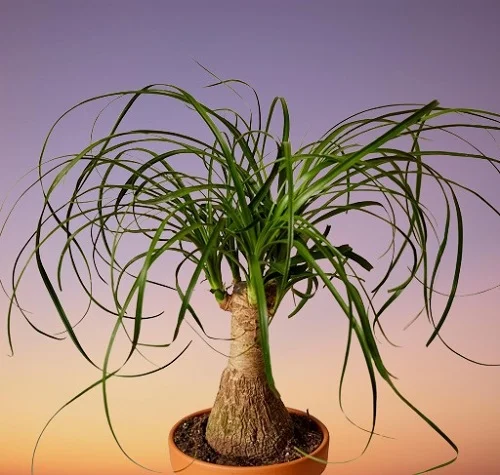
Botanical name: Beaucarnea recurvata
Common names: Ponytail Palm, Elephant Foot
Origin: Tamaulipas, Veracruz and San Luis Potosi in eastern Mexico
Height: 6 ft
Ponytail Palm is a popular succulent plant that does not require a lot of attention which makes it ideal for a beginner or the forgetful plant parent.
This is because the large, swollen bulb which resembles an elephant's foot stores water enabling this plant to go for considerably long periods without being watered. This makes the plant one of the popular hard to kill plants and will withstand some level of neglect.
Beaucarnea recurvata grows best in bright light with some direct sunlight, average warmth, moderate humidity and moderately moist, rich, free-draining, succulents soil coupled with monthly feeding in the growing season.
Read more on how to grow and care for Ponytail Palm (Beaucarnea recurvata)
16. Lady Palm
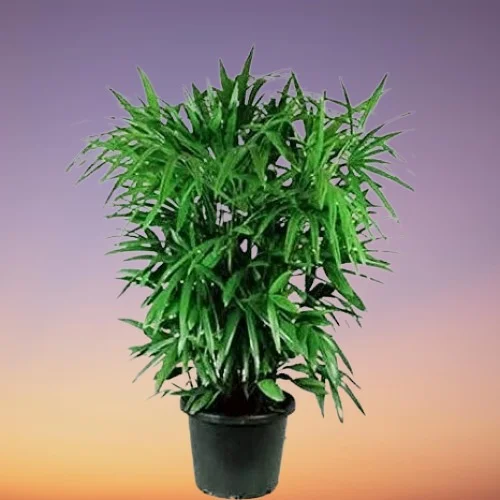
Botanical name: Rhapis excelsa
Common name: Lady Palm
Origin: India and Asia
Height: 6 ft
Lady Palm grows best in bright to medium light, warm and moderately humid conditions and moderately moist, well-drained soil that is rich in organic matter coupled with monthly feeding during the growing season.
Learn more on how to grow and care for Lady Palm (Rhapis excelsa)
17. Ficus Alii
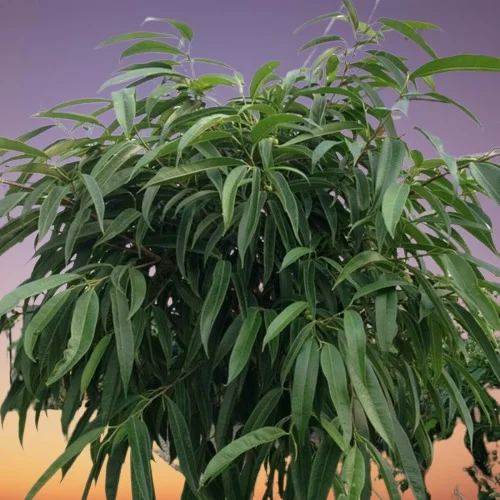
Botanical name: Ficus maclellandii 'Alii'
Common names: Ficus Alii, Banana Leaf Fig, Banana Leaf Ficus, Long Leafed Fig, Narrow Leafed Fig
Origin: Asia, India and China
Height: 9-10 ft
Ficus Alii thrives in bright light with some direct sunlight, warm conditions and moderately moist, rich well-drained soil coupled with monthly feeding during the growing season.
Read more on how to grow and care for Ficus Alii (Ficus maclellandii 'Alii')
18. Canary Island Date Palm
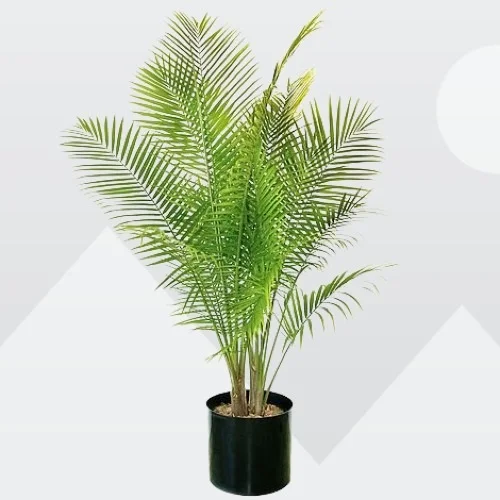
Botanical name: Phoenix canariensis
Common names: Canary Island Date Palm, Pineapple Palm
Origin: Canary Islands
Height: 6 ft
Phoenix canariensis grows best in bright, indirect light, warm and humid conditions and moderately moist, well drained soil that is rich in organic matter coupled with monthly feeding during the growing season.
Learn more on how to grow and care for Canary Island Date Palm (Phoenix canariensis)
19. Buddhist Pine
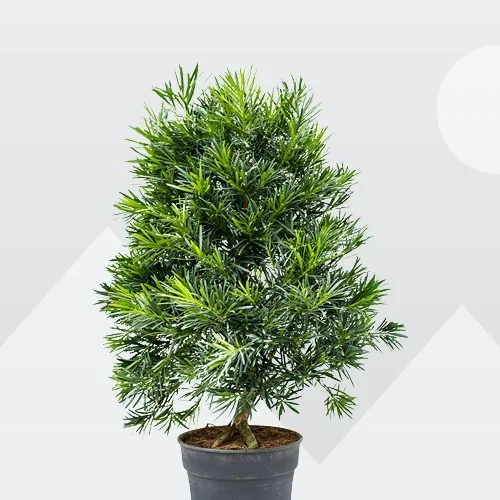
Botanical name: Podocarpus macrophyllus
Common names: Buddhist Pine, Yew Plum Pine, Japanese Yew, Fern Pine
Origin: southern Japan, southern and eastern China
Height: 6 ft
Buddhist Pine also called Yew Plum Pine, Japanese Yew or Fern Pine is a durable plant which does not mind a drafty situation and requires little attention which make it one of the best plants for a front porch or entrance for a great first impression.
The upright stems in Japanese Yew bear dark-green, narrow and glossy, leathery leaves making it a great plant for the any space. With regular pruning it will remain a compact shrub.
Podocarpus macrophyllus flourishes in bright light with 4-6 hours of direct sunlight, average warmth of 15-240C, average humidity of 50-55% and moderately moist, rich, well-drained, all purpose potting soil coupled with monthly feeding during the growing season.
Learn more on how to grow and care for Buddhist Pine (Podocarpus macrophyllus)
20. Weeping Fig
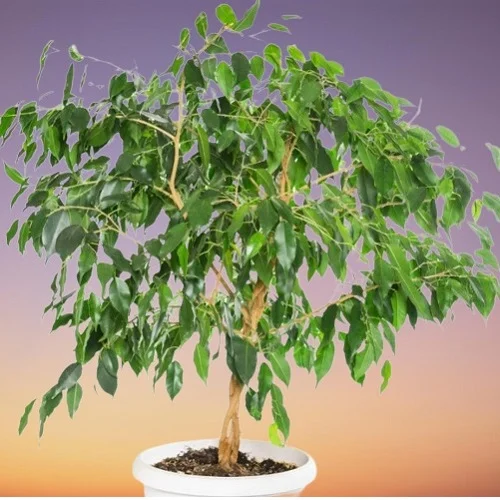
Botanical name: Ficus benjamina
Common names: Weeping Fig, Benjamin Fig, Ficus Tree
Origin: Asia and Australia
Height: 6-8 ft
Weeping Fig (Ficus benjamina) grows best in bright light with some direct sunlight, warm and humid conditions and moderately moist, fertile, well-drained soil coupled with monthly feeding during the growing season.
Learn more on how to grow and care for Weeping Fig (Ficus benjamina)
21. Leea Burgundy
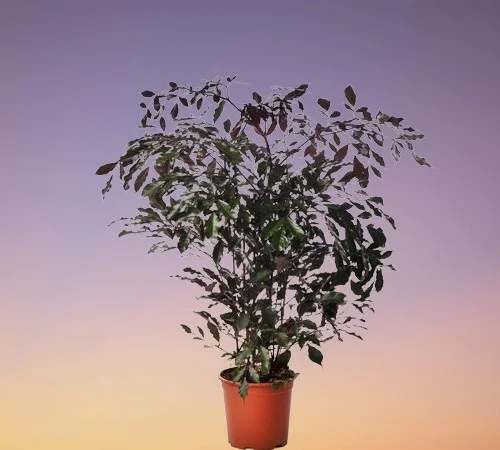
Botanical name: Leea coccinea
Common names: Leea Burgundy, Red Leea, Hawaiian Holly, West Indian Holly 'Rubra'
Origin: Australia, New Guinea, Asia, Africa
Height: 6-8 ft
Leea Burgundy is a rare statement plant whose foliage in young plants is bronzy red but turns green when mature. It is one of the popular purple-leafed plants which creates a great focal point in any space.
Leea coccinea blossoms in medium to bright light (filtered light), average warmth of 18-290C, moderate humidity of 50-55% and consistently moist, fertile, well-drained, all purpose soil coupled with monthly feeding during the growing season.
Learn more on how to grow and care for Leea Burgundy (Leea coccinea)
22. Ficus Yellow Gem
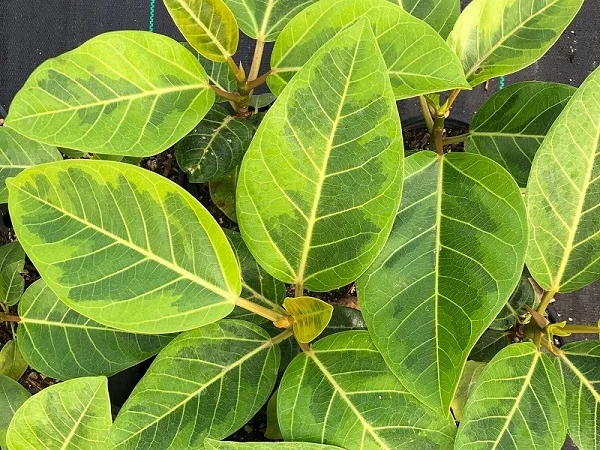
Botanical name: Ficus altissima 'Yellow Gem'
Common names: Ficus Yellow Gem, Council Tree, Lofty Fig
Origin: Southeast Asia
Height: 6-8 ft
Ficus Yellow Gem prefers bright light with some direct sunlight, warm and humid conditions and moderately moist, fertile, well-drained soil coupled with monthly feeding during the growing season.
Learn how to grow and care for Ficus Yellow Gem (Ficus altissima 'Yellow Gem')
23. African Fig Tree

Botanical name: Ficus cyathistipula
Common names: African Fig Tree, Birchbark Fig
Origin: Africa
Height: 6-8 ft
African Fig Tree thrives in bright light with some direct sunlight, warm and humid conditions and moderately moist, fertile, well-drained soil coupled with fortnightly feeding during the growing season.
Read on how to grow and care for African Fig Tree (Ficus cyathistipula)
24. Dracaena deremensis
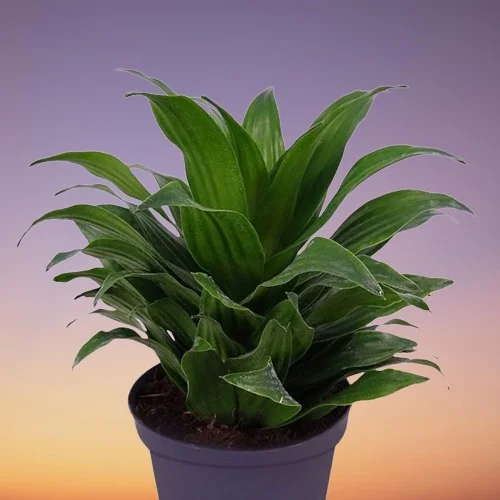
Botanical name: Dracaena deremensis
Common name: Dracaena deremensis
Origin: Tropical Africa and Asia
Height: 4-6 ft
Dracaena deremensis like Dragon Blood Tree (Dracaena draco) grows best in bright, indirect light away from direct sunlight, average warmth, moderate humidity and consistently moist, rich, well-drained, all purpose soil coupled with monthly feeding during the growing season.
Learn more on how to grow and care for Dracaena deremensis
